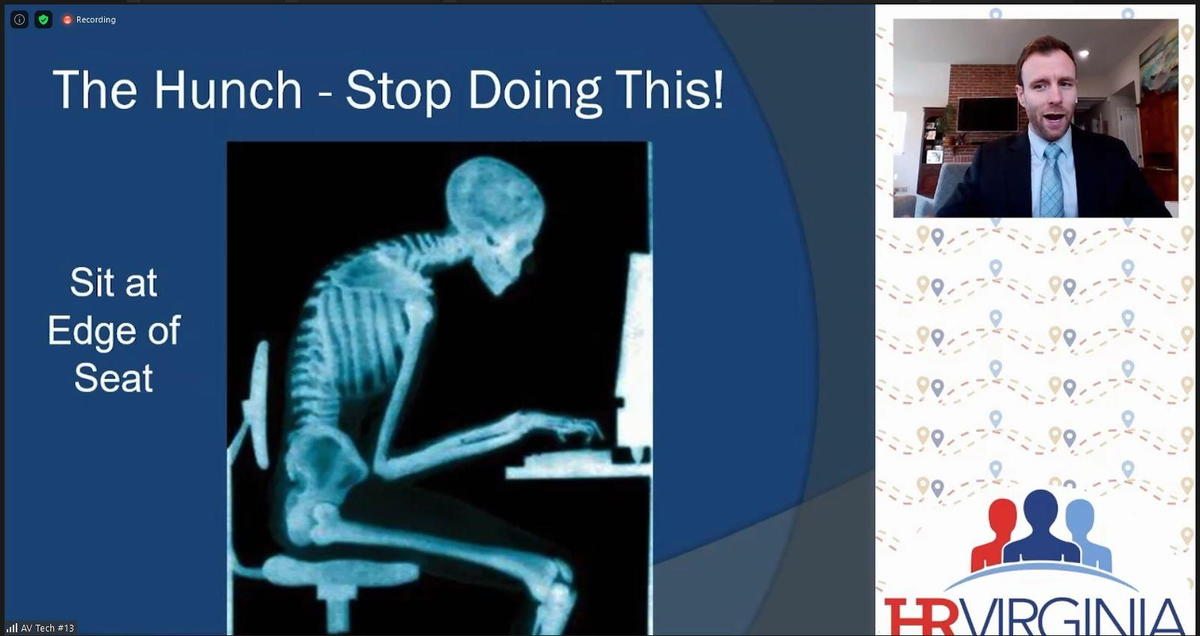Learn simple exercises to alleviate discomfort and have better posture when working at a desk.
Dr. Ward recently spoke at the 2021 HR Virginia Leadership Conference, which was held virtually on January 14 and 15 of this year. The HR Virginia SHRM State Council holds this conference annually in January, which helps others learn and network with other council directors and chapter members.
Speaking about the importance of ergonomics and different office stretches you can perform throughout the day, Dr. Ward explained how having proper posture when working at a desk for long hours can help alleviate chronic back and neck pain. Doing regular stretches and taking plenty of breaks can also help support proper spinal health.
Bruegger Posture Relief Exercise
 Dr. Ward reviewed specific exercises you can do throughout the day, including the Bruegger posture relief exercise, which you can do while sitting or standing.
Dr. Ward reviewed specific exercises you can do throughout the day, including the Bruegger posture relief exercise, which you can do while sitting or standing.
If sitting, sit at the edge of your seat, sit up straight, turn your legs to the side and put your weight on your feet while lifting your chest and leaning your pelvis forward. You can put your arms down by your side with your palms facing away from your body. Hold this position and breathe deep for a few seconds.
If standing, stand up straight and hold your head high, turn your legs outward to the side and, while tilting your pelvic forward and lifting your chest, tighten your abdominal muscles, acting as if you were pulling them in towards your back. Use the same position with your hands, turning your palms outward and breathing deeply, while holding the pose.
Take Microbreaks
 For entertainment value Dr. Ward demonstrates in PJ pants Microbreaks are essential when you’re working at a desk for hours every day. Microbreaks mean taking a break every 30 minutes to get up and stretch or move around, or sooner if you’re feeling stiff or experiencing discomfort. The break doesn’t need to be long—just 30 seconds. Every few hours you can take a longer break to move around or stretch.
For entertainment value Dr. Ward demonstrates in PJ pants Microbreaks are essential when you’re working at a desk for hours every day. Microbreaks mean taking a break every 30 minutes to get up and stretch or move around, or sooner if you’re feeling stiff or experiencing discomfort. The break doesn’t need to be long—just 30 seconds. Every few hours you can take a longer break to move around or stretch.
Other Helpful Tips
Dr. Ward provided other helpful tips for those who need to work longer hours at a desk, which include:
- Considering a standing desk
- Setting a timer to reset your posture or perform one of the exercises
- Taking microbreaks throughout the day
- Asking your partner or coworkers for help
- Having your screen at eye level and pushing your shoulders up
You should also avoid hunching and have eye-level reminders about when to take breaks if you don’t want to set an alarm. Stretches could be as simple as touching your toes, sitting and stretching your neck, or performing the Bruegger posture relief exercise.

